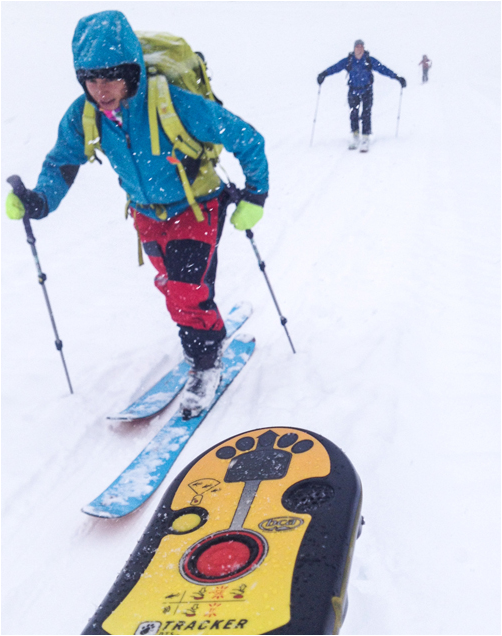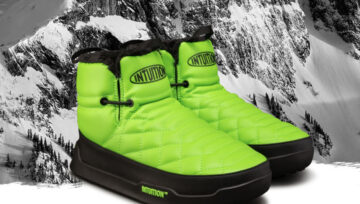Upgrade Your Avalanche Transceiver
Imagine your best friend buried under frozen avalanche debris. Precious minutes have passed, and you are still fumbling around on the debris surface because the outdated transceiver you are searching with is unreliable and malfunctioning.
According to Dale Atkins, former president of the American Avalanche Association and a 30-year avalanche professional, any transceiver more than 10 years old should be retired, even if it has hardly been used. “The electronics and capabilities of modern units are superior to older units,” Atkins says. “.”

Way back in 1997, Backcountry Access introduced the Tracker DTS—the world’s first digital, multi-antenna transceiver—and they’ve since released two more Tracker options. Own something older? Time for an upgrade.
For those clinging to old transceiver, adapting to new technology and features is far less complicated than venturing into avalanche terrain, but don’t be confused: new technology is no substitute for education. For the old-school, search times will be faster, easier and more efficient with a three-antenna transceiver.
Professional and recreational backcountry travelers come up with a whole host of reasons for not needing a new transceiver. Some say they’re really familiar with what they have and that adapting to new technology is too complicated. Others say they are well practiced with a dated transceiver, and still more argue that new transceivers are too expensive. When one of your partners is buried, would you be willing to spend a few hundred dollars to excavate them in a timely manner?
Technology is constantly evolving, and here is what makes a three-antenna transceiver better than your outdated single- or dual-antenna transceiver:
Frequency Drift – a common phenomenon wherein transceivers, over their lifetimes, gradually stray from their 457kHz frequency and may not be recognized by digital transceivers operating on the actual 457kHz frequency.
– Antennae can and do break, which may compromise signal strength and directional arrows.
– By creating a three-dimensional layout, three-antenna transceivers no longer succumb to unexpected “spikes” while pinpointing. They are therefore more accurate with deep burials.
– Advanced features such as marking, flagging or signal suppression may simplify the search process for practiced users in the unlikely event of a multiple burial scenario. It should be noted that these advanced features can and do fail in rare scenarios due to signal overlap, and alternative techniques such as micro search strips need to be learned.
– Now that every avalanche transceiver manufacturer in the world offers a three-antenna transceiver, even dual-antenna transceivers are becoming obsolete.
– While not yet an industry standard, as both guides and educators, when clients arrive with single-antenna analog transceivers, we issue three-antenna transceivers while they are under our professional care.
Time to Upgrade?
If you answer yes to any of the following questions, then it’s time to upgrade your transceiver.
– Has the manufacturer’s warranty expired?
– Does your transceiver have fewer than three antennae?
– Does the manufacturer offer a more recent or updated model?
– Does your employer provide your outdated transceiver?
– Was your transceiver purchased used on the Internet because it was the cheapest one you could find?
– Is your transceiver more than 10 years old? (Professionals who use their transceivers heavily might want to consider an upgrade more frequently.)
Pre-Season Checklist
For those already on board with a three-antenna transceiver, here is a quick, self-guided, pre-season checklist for additional piece of mind.
– Insert new batteries and check for corrosion, loose terminals and that the compartment door seals properly.
– Inspect the unit for physical damage such as a cracked case or broken screen.
– Check that all buttons, switches, display arrows and numbers are functioning.
– If your transceiver has an auto revert function, check that it works. Check your user’s manual to see how your transceiver is programmed.
– Know the manufacturer’s suggested range for your transceiver and perform a range check prior to heading into the backcountry. Anything less than 30 meters is an unacceptable range. There are many variables that affect the range of a transceiver and exact numbers will vary.
– Visit your transceiver’s manufacturer website to determine whether or not your transceiver has the most up-to-date version of firmware.
– If you are at all unsure of your firmware version or the transceiver’s condition, or if the unit is more than five years old, return it to the manufacturer for a diagnostic test.
Get Tuned Up
If you’re still unsure about upgrading your transceiver, know this: three-antenna transceivers are easier to use and are becoming more affordable. A new transceiver is only going to make you faster at something you already know and practice. The old adage holds true; the best function test is practice, and then practice some more.
“Upgrading our brain is just as important as upgrading our gadgets,” says IFMGA-certified guide Tim Brown, “and rescue skills might fade more quickly since we don’t use them as often.” By training regularly with friends and coworkers you’re more likely to run into scenarios that may raise a question about search strategies and a transceiver’s function. Regular practice with touring partners will allow time to critique one another’s skills, and this process will offer piece of mind insuring that you and your partners are tuned up and have transceivers that are operating correctly. And while solid rescue skills are important, a modern AIARE or AAI Level 1 avalanche course focusing on decision making may help you avoid being caught in the first place.
The bottom line? Three-antenna transceivers will soon be the industry standard, and recreational users, as well as industry professionals, educators, guides and outfitters need to follow suit in upgrading. Let’s get with the times: someone’s life may be at stake, and it may be your own.
by Joe Vallone and David Dellamora
Source: backcountrymagazine.com










Comments